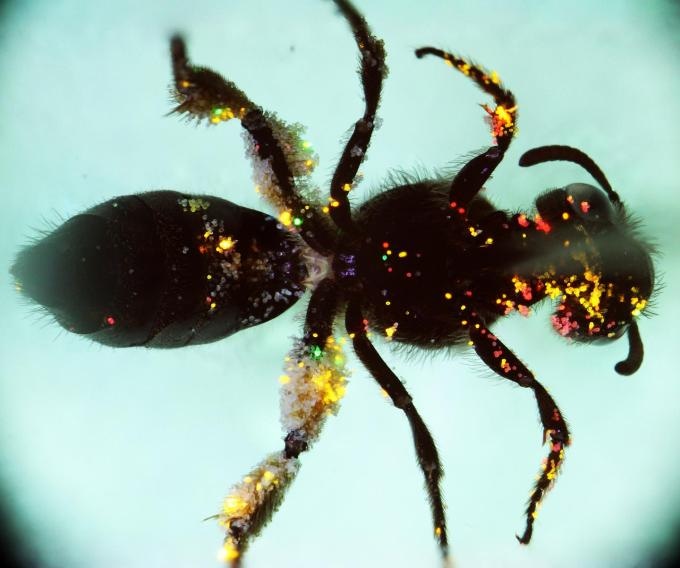Feb 15 2019
At Stellenbosch University, a pollination biologist has been using quantum dots to track the destiny of individual pollen grains. This is proving to be pathbreaking in an area of research that has been affected by the lack of a universal technique for tracking pollen for more than a century.
 This bee was caught after it visited a flower of which the pollen grains were labeled with quantum dots. Under the microscope, one can see where the pollen was placed, and actually determine which insects carry the most pollen from which flower. (Image credit: Corneile Minnaar)
This bee was caught after it visited a flower of which the pollen grains were labeled with quantum dots. Under the microscope, one can see where the pollen was placed, and actually determine which insects carry the most pollen from which flower. (Image credit: Corneile Minnaar)
In an article published this week in the Methods in Ecology and Evolution journal, Dr Corneile Minnaar has reported this innovative technique, which will allow pollination biologists to track the entire pollination process from the first visit by a pollinator to its endpoint—whether transferred successfully to the stigma of another flower or lost on the way.
According to Minnaar, although pollination has been studied in detail for more than 200 years, researchers are not sure about the actual destination of the microscopically tiny pollen grains after leaving flowers: “Plants produce massive amounts of pollen, but it looks like more than 90% of it never reaches stigmas. For the tiny fraction of pollen grains that make their way to stigmas, the journey is often unclear—which pollinators transferred the grains and from where?”
In 2015, Minnaar made decisions to take the path where several others have failed thus far, and accepted the challenge through his PhD research in the Department of Botany and Zoology at Stellenbosch University (SU).
Most plant species on earth are reliant on insects for pollination, including more than 30% of the food crops we eat. With insects facing rapid global decline, it is crucial that we understand which insects are important pollinators of different plants—this starts with tracking pollen.
Dr Corneile Minnaar, Department of Botany and Zoology, Stellenbosch University.
He proposed the concept of a pollen-tracking technique after going through an article related to the use of quantum dots for tracking cancer cells in rats. Quantum dots are very small semiconductor nanocrystals that behave like artificial atoms. Upon being exposed to UV light, they emit extremely bright light in a wide range of possible colors. With regards to pollen grains, he found that quantum dots incorporated with “fat-loving,” or lipophilic, ligands would, in theory, stick to the fatty outer layer of pollen grains, known as pollenkitt. The glowing colors of the quantum dots can then be used to distinctively “label” pollen grains to track where they reach.
The subsequent step was to devise a cost-effective means to observe the fluorescing pollen grains under a field dissection microscope. At that level, Minnaar was still employing a toy pen from a family restaurant that included a little UV LED light, which he borrowed from one of his professors.
I decided to design a fluorescence box that can fit under a dissection microscope. And, because I wanted people to use this method, I designed a box that can easily be 3D-printed at a cost of about R5,000, including the required electronic components.
Dr Corneile Minnaar, Department of Botany and Zoology, Stellenbosch University.
Thus far, the technique and excitation box have been observed to be a straightforward and comparatively low-cost technique for tracking individual pollen grains: “I’ve done studies where I caught the insects after they have visited the plant with quantum-dot labelled anthers, and you can see where the pollen is placed, and which insects actually carry more or less pollen.”
However, the post-labeling part of the study still needs several hours of meticulous counting and checking: “I think I’ve probably counted more than a hundred thousand pollen grains these last three years,” he laughs.
As a postdoctoral fellow in the research team of Prof. Bruce Anderson in the Department of Botany and Zoology at Stellenbosch University, Minnaar will continue to use the technique to explore the several unanswered questions in this field.